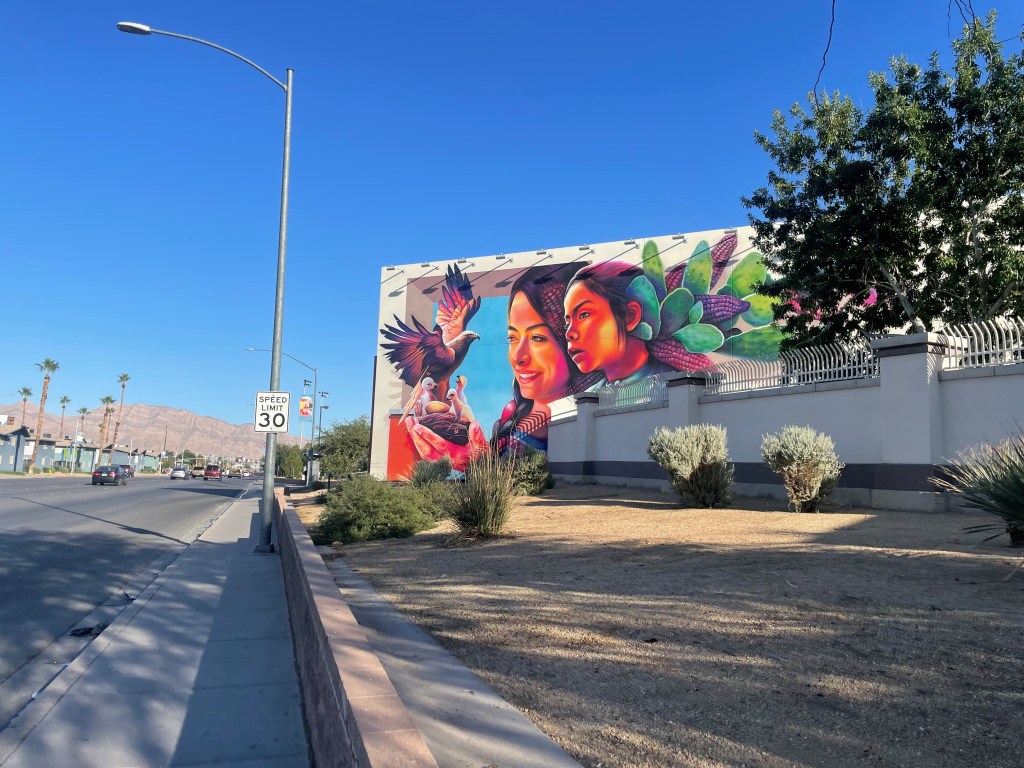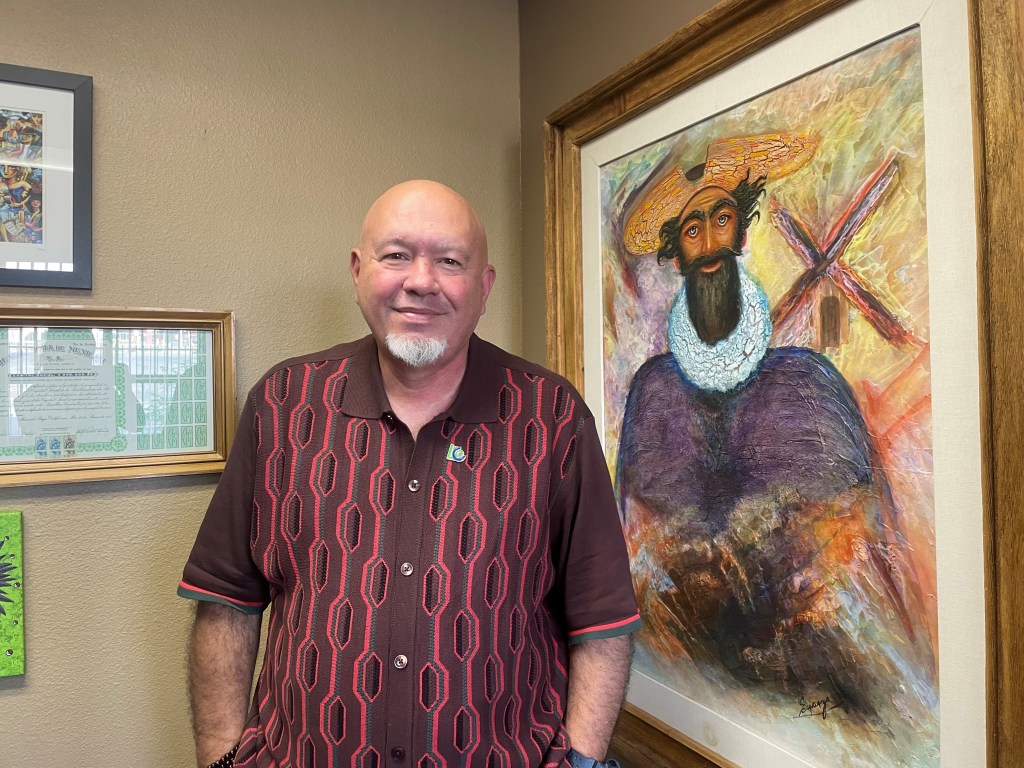Congress has authorized over $1 trillion in spending through the Inflation Reduction Act, the CHIPS and Science Act and the Bipartisan Infrastructure Law. In a new series called “Breaking Ground,” “Marketplace” host Kai Ryssdal will be visiting communities across the country to look at how this infusion of federal dollars might change the economy — in complicated, invisible, even contradictory ways.
In the first episode of the series, Ryssdal explored the legacy of the New Deal and how it reshaped the U.S. economy. In this second episode, Ryssdal travels to Las Vegas to look at how a $24 million federal infrastructure grant could change life in the East Las Vegas neighborhood.
Click the audio player above to hear the full episode.
The Stewart Avenue project
Drive about 6 miles north of the famous Las Vegas Strip, and you’ll be in East Las Vegas. It’s a mostly Latino neighborhood where many of the city’s hotel and casino workers live. A stretch of Stewart Avenue — a main street in this part of town — is set to be transformed with federal funding from the Department of Transportation’s RAISE, or Rebuilding American Infrastructure with Sustainability and Equity, program.
The Bipartisan Infrastructure Law provides $1.5 billion annually for the program from 2022 to 2026. A spokesperson said the DoT has awarded $4.5 billion in RAISE grants since the law was passed.
A portion of RAISE funding is designated for “areas of persistent poverty.” East Las Vegas qualifies: 28% of its residents live below the poverty threshold.
In 2022, the city of Las Vegas won a $23.9 million RAISE grant to upgrade a 4-mile stretch of Stewart Avenue. Las Vegas will match the federal dollars with $23.9 million of its own. The project will upgrade Stewart by adding bike lanes, improving bus stops, expanding sidewalks and lowering the speed limit. To add shade, 700 trees will be installed. Many of these changes are designed to make Stewart Avenue safer for pedestrians because 20% of households in the area don’t have a car.
Stewart Avenue today
Ryssdal made three stops along the corridor of Stewart Avenue that will be affected by the infrastructure project. The first was at the intersection of 28th Street, where three schools are within walking distance. The city measured foot traffic there as part of its RAISE application and found that around 200 pedestrians cross the street each day after school lets out.
“There’s a lot of running the lights here,” crossing guard Kim Hanley told Ryssdal, who spent a Monday afternoon shift with her. “So we pretty much have to hold off the kids.”

Hanley has been working as a crossing guard for over a year and a half to supplement her Social Security. She enjoys seeing the same kids every day. When asked, she said the worst part of the job is the weather, and there’s no tree cover on Stewart Avenue.
“You never get used to it,” Hanley said of the heat. “You know, I put ice packs on me because that’s about all you can do.”
Ryssdal stopped next at the East Las Vegas Community Center, where Guillermo Bonnet-Laboy is recreation coordinator. He called the ELVCC “the heart of the east side of the Hispanic community.”
The center offers programming for children and adults, and many seniors spend their mornings there, eating a low-cost breakfast and then playing chess or pool. There are rooms throughout the center that offer free computer access and classes in English as a second language.

Bonnet-Laboy was born in the Dominican Republic and moved to Las Vegas at 3 years old. His father works as a bilingual science teacher at a Las Vegas middle school, and his mother was a district manager with Burger King.
“So they did pretty well for themselves,” he said. “But as all people who move here, there was a little bit of struggle at the beginning. And that’s kind of how I found my way here — by providing for the community, people similar to me, opportunities so that they can be in jobs like my mom had or my dad has or I have.”
The Latin Chamber of Commerce Nevada, Ryssdal’s third stop, is about a mile west of the ELVCC. Carlos Gomez, the vice president of business development, works with many East Las Vegas businesses. He said Stewart Avenue needs to be upgraded, but he anticipates pain during construction.

“I’ll tell you the experience we had on Fremont Street and Eastern, which is close to this area, when they did the sewer system,” Gomez said. “Businesses weren’t ready for the traffic problems and [the reduction in] foot traffic, so they lost everything there. It is really painful, but it needs to be done in order to have a better future.”
Behind the grant
Ryssdal also spent an afternoon with Joey Paskey. She’s director of the Las Vegas Public Works Department, which is overseeing the federal grant. Ryssdal asked her why the agency chose to apply for funding for the Stewart Avenue project.
“That part of town has been really neglected in terms of our infrastructure,” Paskey said. “It has not kept up with the glitz and the glamour of everything else. And quite honestly, it was time. We have a big focus on safety here. We have looked at all the roads, and we know which cause the most fatalities and serious injuries. A chunk of Stewart is one of those.“
Paskey said improving Stewart Avenue has long been on the department’s wish list. After a detailed application process, it learned that it won the grant in August 2022. Today, Public Works still doesn’t have the federal money, but it’s permitted to use the city’s $24 million match to start the project.
Ryssdal asked Paskey what she’d want President Joe Biden to know about her experience. In addition to the RAISE grant for Stewart Avenue, the agency is managing three federal grants funded by the Bipartisan Infrastructure Law.
“I want him to know that this is working,” Paskey said. “I think we all know it’s not enough money. It’s a historical amount of money, and we might never see it again. But I think everybody needs to know it’s still not enough to maintain what we have. But hey, it’s a great start, and we’ll take anything we can to make things better.”
Paskey anticipates the city will be done with construction on Stewart Avenue in 2031.
There’s a lot happening in the world. Through it all, Marketplace is here for you.
You rely on Marketplace to break down the world’s events and tell you how it affects you in a fact-based, approachable way. We rely on your financial support to keep making that possible.
Your donation today powers the independent journalism that you rely on. For just $5/month, you can help sustain Marketplace so we can keep reporting on the things that matter to you.



